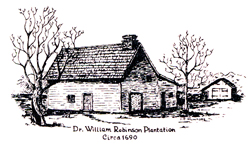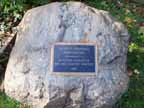 Dr. Wm. Robinson Plantation & Museum Circa
1690
|
| | HOME | | HISTORY | | EVENTS | | HERB GARDEN | | NEWSLETTER | | HISTORICAL SOCIETY | | LINKS | | KIDS | | CONTACT | |
|
HERBS
Herbs are plants, whose stems die down to the ground after
flowering. Their stems are fleshy and often green. Edible herbs differ
from vegetables in that they are used to
flavor other dishes while vegetables are eaten for
themselves.Exceptions
are celery, carrots and onions which are
considered vegetables but are also used to flavor other dishes. Such
herbs as
fennel, angelica and lovage can be eaten as vegetables.
Herbs were grown to flavor foods, as beauty aids and for their pleasant fragrance, which covered some unpleasant odors. They added zest to culinary foods and made life easier. Many of the herbs were used as medicine, for healing as well as easing pain.Some herbs were introduced to the American Indians; others were introduced to the Europeans by the Native Americans, especially those plants that were native to this country. Years ago people looked into their gardens for cures instead of into a medicine cabinet. Legend and tradition have attributed many medical properties to herbs, some of which have been substantiated by modern science. Many of today’s drugs are taken from herbal remedies. They were believed to have magical qualities, in the realm of the super-natural. Legend, lore or whatever we believe, we still use many herbs as the colonists did. They may be in different form (grocery bought, etc.) but many of us still glean from our gardens the basil, mint, chives and oregano, the parsley, sage, thyme, marjoram and garlic.
Instructions
from the Workshop on May 16th.
After you take
your garden home, follow these steps to care for your herbs. Place you
container on top of the
refrigerator or someplace where it will get heat from the bottom.
It should take
5-14 days for the seeds to
begin growing, depending on the plants.
Once you see
most of the container with
tiny sprouts, place the container where it will get bright light all
day.
Keep the soil
moist but not real wet.
When the
plants have several sets of leaves on them and
begin filling up
the container, it is time to find them a permanent home.
If you want to
keep the herbs inside on a window sill, just
find a
container that will fit and fill it with potting soil.
Remove the
plants carefully from the starter garden and
transplant them to
their new containers.
Be
careful not to overcrowd them, use more containers or share them with
friends
and family.
If you want to
transplant them outside you have to get the young plants use to the
outside
temperatures.
A week
before you are ready to plant outside, put the plants outside during
the day
out of direct sunlight. Bring them in at night if the temperature is
cool.
Try to
plant the herbs outside on a cloudy day.
Prepare
the ground with some potting soil before putting the new plants in the
ground.
Water
well, but do not flood the ground.
The
more you use the herbs the more they grow. For more information visit
the
internet or library.
|
| ©
2009 Lisa Jennings. All Rights Reserved. |





